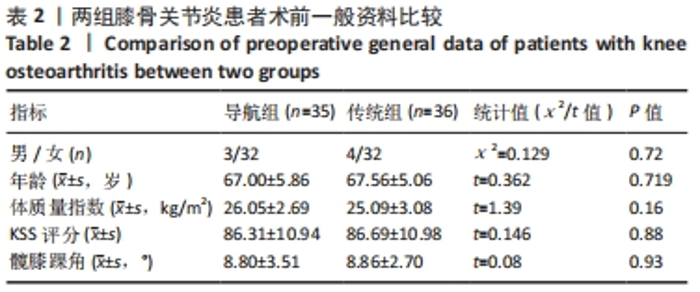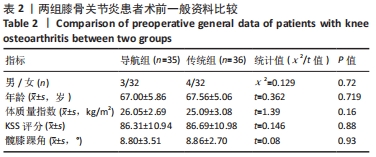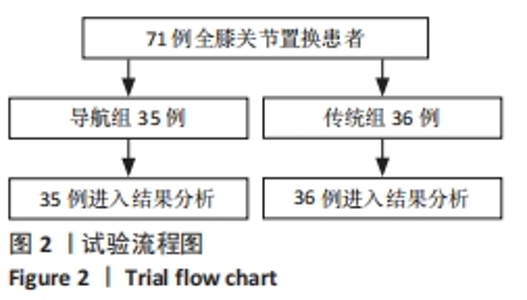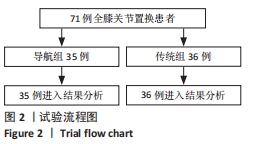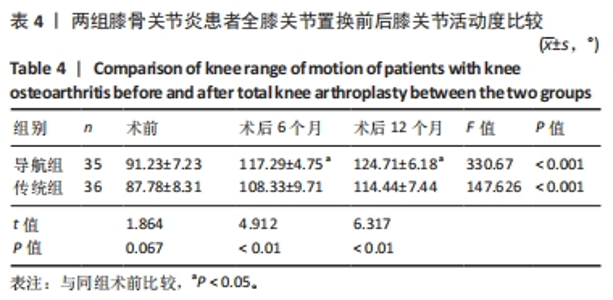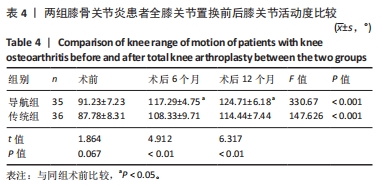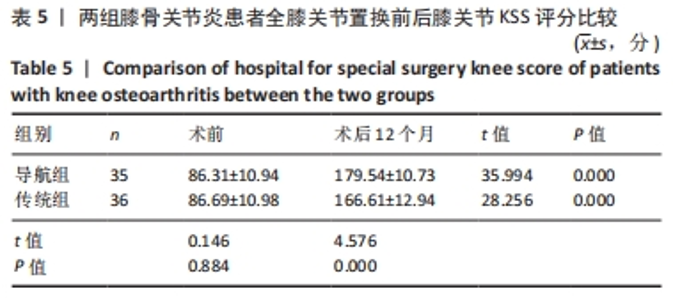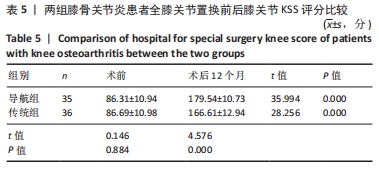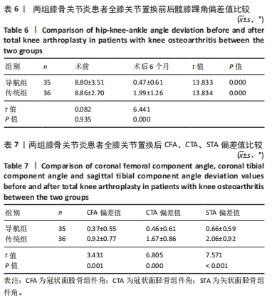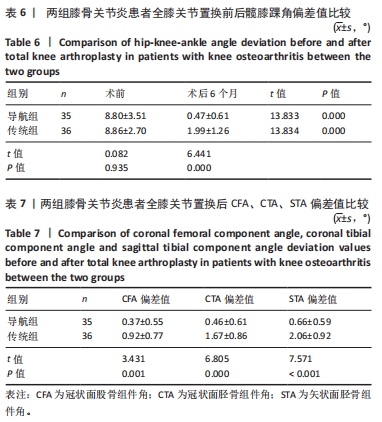Chinese Journal of Tissue Engineering Research ›› 2024, Vol. 28 ›› Issue (33): 5333-5339.doi: 10.12307/2024.655
Previous Articles Next Articles
Application advantages of Brainlab Knee 3 navigation combined with gap balance in total knee arthroplasty
Sun Jinghua, Qi Zhiming, Ruan Wenli, Zhang Jiaguo, Yang Zhitong
- Dalian Second People’s Hospital, Dalian 116100, Liaoning Province, China
-
Received:2023-08-07Accepted:2023-10-20Online:2024-11-28Published:2024-01-30 -
Contact:Ruan Wenli, Chief physician, Dalian Second People’s Hospital, Dalian 116100, Liaoning Province, China -
About author:Sun Jinghua, MD, Chief physician, Dalian Second People’s Hospital, Dalian 116100, Liaoning Province, China -
Supported by:Dalian Dengfeng Project (to QZM)
CLC Number:
Cite this article
Sun Jinghua, Qi Zhiming, Ruan Wenli, Zhang Jiaguo, Yang Zhitong. Application advantages of Brainlab Knee 3 navigation combined with gap balance in total knee arthroplasty[J]. Chinese Journal of Tissue Engineering Research, 2024, 28(33): 5333-5339.
share this article
Add to citation manager EndNote|Reference Manager|ProCite|BibTeX|RefWorks
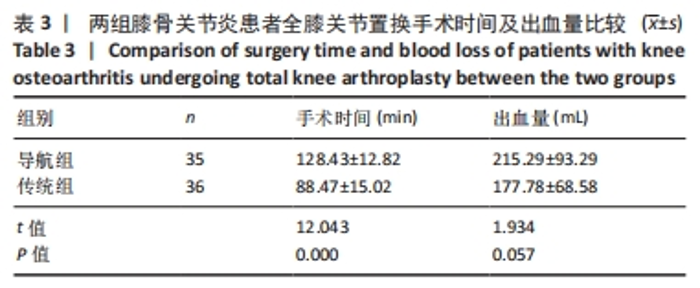
2.4 间隙平衡 导航组伸直位内外侧间隙差:19例为0 mm,14例为1 mm,2例为2 mm;传统组伸直位内外侧间隙差:10例为0 mm,20例为1 mm,6例为2 mm,两组比较差异有显著性意义(χ2 =-2.799,P=0.005)。导航组屈膝90°位内外侧间隙差:18例为0 mm,15例为1 mm,2例2 mm;传统组屈膝90°位内外侧间隙差:13例为0 mm,15例为1 mm,8例为2 mm,两组比较差异有显著性意义(χ2=-3.606,P < 0.01)。所有患者均达到屈伸间隙平衡。 2.5 手术时间、术中出血量、并发症 导航组患者术后未输血,切口愈合良好,2例患者术后常规B超检查发现下肢肌间静脉血栓形成,给予皮下注射低分子肝素治疗,出院后3-6个月复查彩超显示双下肢肌间静脉血栓消失。传统组患者术后未输血,切口愈合良好,随访无感染病例发生。导航组手术时间明显长于传统组,差异有显著性意义(P < 0.05),两组术中出血量比较差异无显著性意义(P > 0.05),见表3,导航技术的初始时手术时间长,与传统组比较需要30-40 min的时间用以配准及调整截骨计划。"
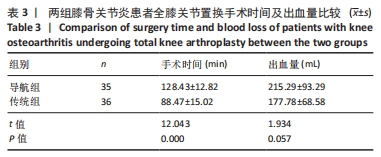
| [1] 边焱焱,程开源,常晓,等.2011至2019年中国人工髋膝关节置换手术量的初步统计与分析[J].中华骨科杂志,2020,40(21):1453-1460. [2] TREU EA, FRANDSEN JJ, WOODLEY CD, et al. Accelerometer-Based Navigation in Primary Total Knee Arthroplasty Leads to Improved Alignment but No Change in Patient-Reported Outcomes. J Arthroplasty. 2023;38(6S):S222-S226. [3] HERNÁNDEZ-VAQUERO D, SUAREZ-VAZQUEZ A, SANDOVAL-GARCIA MA, et al. Computer assistance increases precision of component placement in total knee arthroplasty with articular deformity. Clin Orthop Relat Res. 2010;468(5):1237-1241. [4] JONES CW, JERABEK SA. Current Role of Computer Navigation in Total Knee Arthroplasty. J Arthroplasty. 2018;33(7):1989-1993. [5] KHUANGSIRIKUL S, LEKKREUSUWAN K, CHOTANAPHUTI T. 10-Year patient satisfaction compared between computer-assisted navigation and conventional techniques in minimally invasive surgery total knee arthroplasty. Comput Assist Surg (Abingdon). 2016;21(1):172-175. [6] MCCLELLAND JA, WEBSTER KE, RAMTEKE AA, et al. Total knee arthroplasty with computer-assisted navigation more closely replicates normal knee biomechanics than conventional surgery. Knee. 2017; 24(3):651-656. [7] GRAICHEN H, LUDERER V, STRAUCH M, et al. Navigated, gap-balanced, adjusted mechanical alignment achieves alignment and balancing goals in a very high percentage but with partially non-anatomical resections. Knee Surg Sports Traumatol Arthrosc. 2023;31(3):768-776. [8] EWALD FC. The Knee Society total knee arthroplasty roentgenographic evaluation and scoring system. Clin Orthop Relat Res. 1989;(248):9-12. [9] WEISS JM, NOBLE PC, CONDITT MA, et al. What functional activities are important to patients with knee replacements? Clin Orthop Relat Res. 2002;(404):172-188. [10] SONG EK, SEON JK, PARK SJ. Flexion-extension gaps balanced using navigation assistance in TKA. Orthopedics. 2009;32(10 Suppl):26-30. [11] LIVERMORE AT, ERICKSON JA, BLACKBURN B, et al. Does the sequential addition of accelerometer-based navigation and sensor-guided ligament balancing improve outcomes in TKA? Bone Joint J. 2020; 102-B(6_Supple_A):24-30. [12] HETAIMISH BM, KHAN MM, SIMUNOVIC N, et al. Meta-analysis of navigation vs conventional total knee arthroplasty. J Arthroplasty. 2012;27(6):1177-1182. [13] JENNY JY, BOERI C. Unicompartmental knee prosthesis implantation with a non-image-based navigation system: rationale, technique, case-control comparative study with a conventional instrumented implantation. Knee Surg Sports Traumatol Arthrosc. 2003;11(1):40-45. [14] SUERO EM, LUEKE U, STUEBIG T, et al. Computer navigation for total knee arthroplasty achieves better postoperative alignment compared to conventional and patient-specific instrumentation in a low-volume setting. Orthop Traumatol Surg Res. 2018;104(7):971-975. [15] RHEE SJ, KIM HJ, LEE CR, et al. A Comparison of Long-Term Outcomes of Computer-Navigated and Conventional Total Knee Arthroplasty: A Meta-Analysis of Randomized Controlled Trials. J Bone Joint Surg Am. 2019;101(20):1875-1885. [16] TODESCA A, GARRO L, PENNA M, et al. Conventional versus computer-navigated TKA: a prospective randomized study. Knee Surg Sports Traumatol Arthrosc. 2017;25(6):1778-1783. [17] TANDOGAN RN, KORT NP, ERCIN E, et al. Computer-assisted surgery and patient-specific instrumentation improve the accuracy of tibial baseplate rotation in total knee arthroplasty compared to conventional instrumentation: a systematic review and meta-analysis. Knee Surg Sports Traumatol Arthrosc. 2022;30(8):2654-2665. [18] ZHAO L, XU F, LAO S, et al. Comparison of the clinical effects of computer-assisted and traditional techniques in bilateral total knee arthroplasty: A meta-analysis of randomized controlled trials. PLoS One. 2020;15(9):e0239341. [19] KANG KT, KOH YG, SON J, et al. Influence of Increased Posterior Tibial Slope in Total Knee Arthroplasty on Knee Joint Biomechanics: A Computational Simulation Study. J Arthroplasty. 2018;33(2):572-579. [20] BOVÉ JC, CLAVÉ A. Navigated total knee arthroplasty: Retrospective study of 600 continuous cases. Orthop Traumatol Surg Res. 2021; 107(3):102857. [21] MILLAR NL, DEAKIN AH, MILLAR LL, et al. Blood loss following total knee replacement in the morbidly obese: Effects of computer navigation. Knee. 2011;18(2):108-112. [22] QUAYLE J, KLASAN A, FRAMPTON C, et al. Do TKAs in Patients with Higher BMI Take Longer, and is the Difference Associated with Surgeon Volume? A Large-database Study from a National Arthroplasty Registry. Clin Orthop Relat Res. 2022;480(4):714-721. [23] DE STEIGER RN, LIU YL, GRAVES SE. Computer navigation for total knee arthroplasty reduces revision rate for patients less than sixty-five years of age. J Bone Joint Surg Am. 2015;97(8):635-642. [24] FARHAN-ALANIE OM, ALTELL T, O’DONNELL S, et al. No advantage with navigated versus conventional mechanically aligned total knee arthroplasty-10 year results of a randomised controlled trial. Knee Surg Sports Traumatol Arthrosc. 2023;31(3):751-759. [25] MCAULIFFE MJ, BEER BR, HATCH JJ, et al. Impact of Image-Derived Instrumentation on Total Knee Arthroplasty Revision Rates: An Analysis of 83,823 Procedures from the Australian Orthopaedic Association National Joint Replacement Registry. J Bone Joint Surg Am. 2019;101(7):580-588. [26] VAN ONSEM S, VERSTRAETE M, DHONT S, et al. Improved walking distance and range of motion predict patient satisfaction after TKA. Knee Surg Sports Traumatol Arthrosc. 2018;26(11):3272-3279. [27] HASSABALLA MA, PORTEOUS AJ, NEWMAN JH, et al. Can knees kneel? Kneeling ability after total, unicompartmental and patellofemoral knee arthroplasty. Knee. 2003;10(2):155-160. [28] 孙厚义,郑恺,张韦成,等.OrthoPilot计算机导航辅助全膝关节置换术的早期学习曲线[J].中华骨科杂志,2021,41(6):350-358. |
| [1] | Shan Jiaxin, Zhang Yilong, Wu Hongtao, Zhang Jiayuan, Li Anan, Liu Wengang, Xu Xuemeng, Zhao Chuanxi. Changes in muscle strength and pain in patients receiving Jianpi Yiqi Huoxue Formula after total knee arthroplasty [J]. Chinese Journal of Tissue Engineering Research, 2024, 28(9): 1378-1382. |
| [2] | Qi Haodong, Lu Chao, Xu Hanbo, Wang Mengfei, Hao Yangquan. Effect of diabetes mellitus on perioperative blood loss and pain after primary total knee arthroplasty [J]. Chinese Journal of Tissue Engineering Research, 2024, 28(9): 1383-1387. |
| [3] | Li Xiaoqiang, Chen Wei, Li Mingyue, Shan Tianchi, Shen Wen. Value of preoperative quantitative ultrasound analysis of quadriceps femoris in predicting chronic post-surgical pain after total knee arthroplasty [J]. Chinese Journal of Tissue Engineering Research, 2024, 28(9): 1388-1393. |
| [4] | Han Bing, Liu Hongbin, Wang Hehong, Zhao Hanqing, Zhao Riguang, Sun Yiyan, Zhang Yu. Correlation between lower limb alignment and risk factors of patellofemoral pain syndrome in young men [J]. Chinese Journal of Tissue Engineering Research, 2024, 28(8): 1211-1216. |
| [5] | Wang Tihui, Wang Xu, Wu Jinqing, Chen Jiliang, Wang Xiaolu, Miao Juan. Application of three-dimensional simulated osteotomy of the distal femur in total knee arthroplasty [J]. Chinese Journal of Tissue Engineering Research, 2024, 28(6): 905-910. |
| [6] | Yang Yifeng, Huang Jian, Ye Nan, Wang Lin. Ischemia-reperfusion injury in total knee arthroplasty [J]. Chinese Journal of Tissue Engineering Research, 2024, 28(6): 955-960. |
| [7] | Lin Ying, Liao Qi, Yan Laixiu, Lai Jianhong. Risk factors of delirium after total knee arthroplasty in elderly patients and establishment of nomogram prediction model [J]. Chinese Journal of Tissue Engineering Research, 2024, 28(33): 5340-5345. |
| [8] | Li Zhengyuan, Hao Lin, Chen Shenghong, Peng Kai, Wang Jun, Yin Zongsheng. Topical application of vancomycin in prevention of early incision infection in total knee arthroplasty [J]. Chinese Journal of Tissue Engineering Research, 2024, 28(33): 5346-5350. |
| [9] | Fu Qiangchang, Zheng Liming, Jiang Lifeng. High tibial osteotomy promotes cartilage regeneration in the treatment of knee osteoarthritis [J]. Chinese Journal of Tissue Engineering Research, 2024, 28(32): 5243-5248. |
| [10] | Wang Ruoyu, Zhang Zhifeng, Huang Jian. Application and prospect of robotic-assisted total knee arthroplasty [J]. Chinese Journal of Tissue Engineering Research, 2024, 28(30): 4889-4895. |
| [11] | Wang Tihui, Wang Xu, Wu Jinqing, Chen Jiliang, Wang Qijin, Xu Hongwei, Lin Jianguo. Moderate and severe valgus knee by total knee arthroplasty through medial and lateral parapatellar approach [J]. Chinese Journal of Tissue Engineering Research, 2024, 28(30): 4825-4830. |
| [12] | Huang Xueli, Luo Ruiqin, Chen Sheng, Li Xiaowu, Chen Haibo, Zeng Qingqiang, Zheng Zhihui. Application of balance technique and measurement osteotomy technique under Offset Repo-Tensor in total knee arthroplasty [J]. Chinese Journal of Tissue Engineering Research, 2024, 28(24): 3822-3826. |
| [13] | Geng Haoyang, Liu Wenping, Wang Guorui, Liu Bin, Wang Wei, Ma Zhanqiao, Wang Jianhua. Effect of adductor canal block and single sciatic nerve block combined with analgesic drugs on pain after total knee arthroplasty [J]. Chinese Journal of Tissue Engineering Research, 2024, 28(24): 3833-3838. |
| [14] | Chen Jiahao, Feng Shuo, Wang Hu, Zhang Qiang, Chen Xiangyang. Value of mean platelet volume combined with thromboelastography in predicting thrombosis after total knee arthroplasty [J]. Chinese Journal of Tissue Engineering Research, 2024, 28(21): 3334-3338. |
| [15] | Yang Yongze, Cheng Qinghao, Zhang Anren, Yang Xin, Zhang Zhuangzhuang, Fan Hua, Zhang Fukang, Guo Hongzhang. Advantages and disadvantages of trauma effects during robot-assisted total knee arthroplasty [J]. Chinese Journal of Tissue Engineering Research, 2024, 28(21): 3413-3417. |
| Viewed | ||||||
|
Full text |
|
|||||
|
Abstract |
|
|||||
